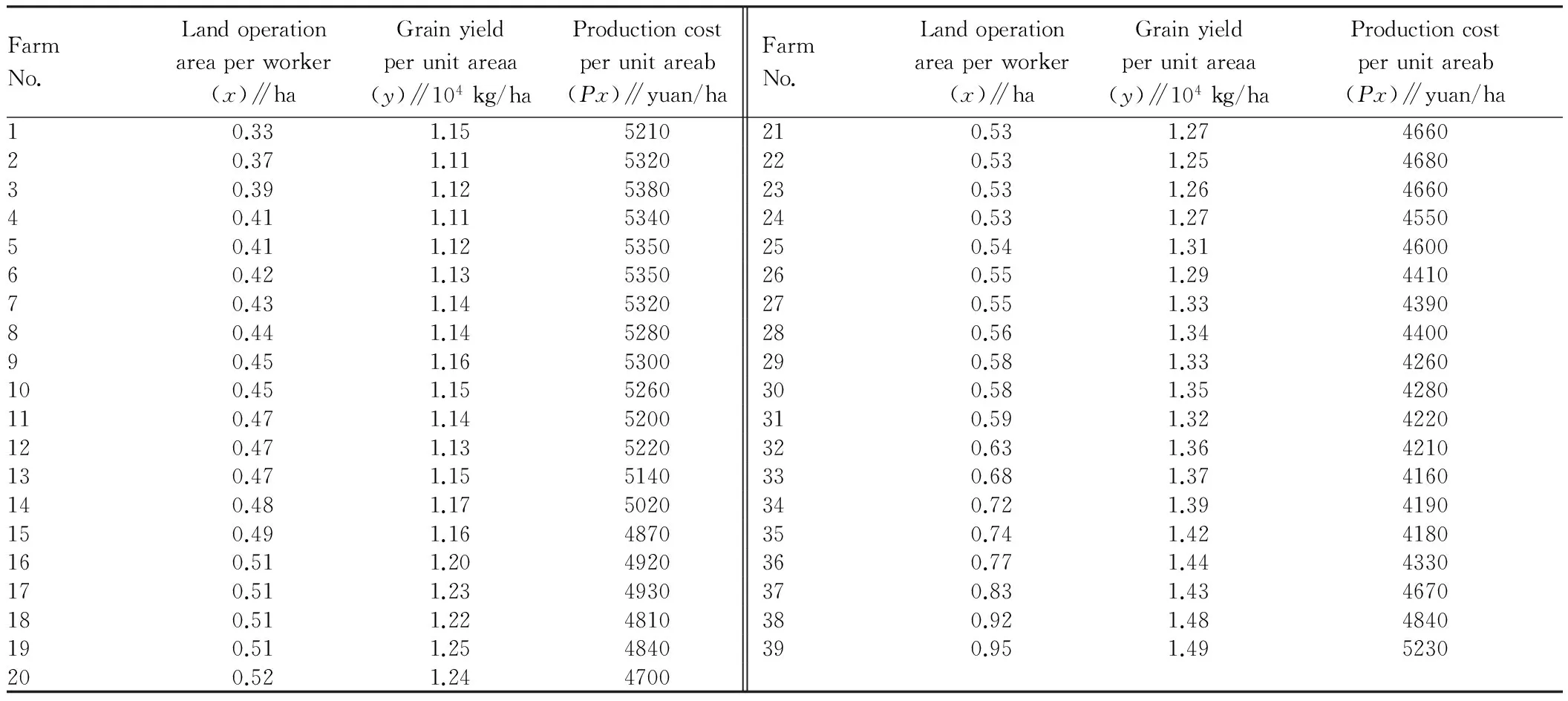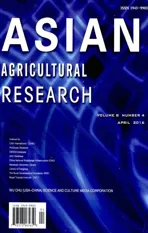An Empirical Study on the Moderate Scale of Food-production-based Family Farm in Guangxi
2016-01-11
College of Law and Business, Guangxi College of Education, Nanning 530023, China
1 Introduction
The 18th CPC National Congress pointed out that we will develop various forms of scale operation, and build an intensive, specialized, organizational and socialized new agricultural management system. Central Document No. 1 in 2013 and the Third Plenary Session of the 18th Central Committee of the CPC also emphasized encouraging and supporting the transfer of rural contracted land to family farm and other large-scale business entities, and proposed development of various forms of moderate scale operation. "Family farm" has caused great concern and discussion, and "moderate scale" also becomes a hot spot of theoretical studies. It has rapidly set off a wave of starting up "family farm" nationwide. Foreign and domestic studies generally regard land area as the basic criterion and standard to measure agricultural production scale, and focus on the relationship between land scale and economic benefits. In recent years, the domestic experts and scholars have done a lot of researches on measurement of moderate scale family farm, and their research methods are mainly based on the analysis about resources endowment in different regions, business environment, productivity level and other factors of production. However, because of geographical differences, and different degrees of economic development and market development, their findings are confined to specific scope, which shows that the moderate scale of agricultural land is difficult to have a value of general applicability[1]. In this study, with Guigang City in Guangxi as a typical area and food-production-based family farm as the object of study, from the perspective of maximizing the income of rural households, we establish the production function measurement model, use questionnaire data to perform the empirical analysis on moderate scale of family farm in the study area, and finally make recommendations, in order to provide decision-making basis and case support for Guangxi to build a modern agricultural management system and cultivate new agricultural business entities.
2 Study area and sample selection
2.1OverviewofstudyareaGuigang City lies in the southeast of Guangxi, having jurisdiction over Gangbei District, Gangnan District, Qintang District, Guiping City and Pingnan County. It has a total population of 4.1868 million, and a rural population of 2.36 million. The farmland area is 0.3618 million ha, and grain sown area is 0.2718 million ha. The city builds 11 high-yield grain production demonstration zones, to create 1.4608 million t of total grain output and achieve output value of 3.877 billion yuan. On April 2, 2013, Guangxi Autonomous Region’s government held spring agricultural production work meeting, and proposed the first development of family farms in Guigang, so Guigang becomes a pioneer in Guangxi’s development of family farms. According to the statistics of Guigang Municipal Bureau of Agriculture, as of December 31, 2013, 691 family farms were registered in Guigang, with registered capital of 309 million yuan and 2614 full-time practitioners, accounting for 68.1%, 66.5% and 62.1%, respectively in the entire region.
2.2SurveysampleThe data used in this study are from the questionnaire survey conducted our research group. In 2014, the research group extracted 40 food-production-based family farms as survey samples, accounting for 12.35% of total food-production-based family farms in the whole city, and 39 valid questionnaires were returned. The survey involves basic situation of family, arable land area, agricultural operating costs and benefits. From Table 1, it can be found that the current land management scale of family farms in Guigang is generally small, with the smallest farming area of only 1.57 ha and the largest area of 16.67 ha; there are 29 family farms with management scale of less than 4 ha, accounting for 65.91%; there are only 7 family farms with management scale of more than 6 ha, only accounting for 15.9%; in terms of the labor scale, the largest amount of labor in the household owning family farms is 5.5, the smallest amount of labor employed annually is 1.34, and the average annual number of effective total labor is 9.5; in terms of labor productivity, the farming area per worker is less than 1 ha.
Table1SamplingsurveyofthefamilyfarmsinGuigangCityin2014

GroupNo.Operatingarea∥haNumberofhouseholdsAmountofagriculturallaborperhouseholdAnnualamountofemployedlaborperhouseholdArablelandareaperworker∥ha1≦233.331.340.3922-3103.732.820.4533-4133.674.740.5844-673.887.130.7356-1044.4010.600.766≧1025.5015.500.97
3 Measurement on moderate scale of family farms
3.1FunctionmodelbuildingIn evaluation and estimation of moderate scale operation of agricultural land, the most commonly used methods are visual assessment method, group comparison method, comprehensive evaluation method, and production function analysis[2]. In this study, the production function analysis is employed. Function analysis takes the scale at the lowest point of long-run average cost curve as moderate land scale, and its principle is to build production function model between land operation scale and evaluation indicators, and then use the marginal balance principle to analyze and calculate the moderate scale when the net income is highest. In this study, we use the sample data on 39 food-production-based family farms, to directly build production function model. According to the scatter plot, we select the functional form of logarithmic curve:
y=a+blnx
whereyis grain yield per unit area;xis the farming area per worker in family farm.
According to the model, we can calculate the moderate scale of land in family farm.
3.2ModeltestingandparametercalculationThe basic production of 39 food-production-based family farm samples can be shown in Table 2. Based on the sample survey data in Table 2, we use the least squares method to calculate the parameteraat 0.9645,bat 0.106, as shown in Fig. 3. The production function model established isy=0.9645+0.106lnx. The correlation coefficientr=0.815, the statistical test is significant, and the model can be used for analysis.
Table2Thebasicproductionoffamilyfarmsamples

FarmNo.Landoperationareaperworker(x)∥haGrainyieldperunitareaa(y)∥104kg/haProductioncostperunitareab(Px)∥yuan/haFarmNo.Landoperationareaperworker(x)∥haGrainyieldperunitareaa(y)∥104kg/haProductioncostperunitareab(Px)∥yuan/ha10.331.155210210.531.27466020.371.115320220.531.25468030.391.125380230.531.26466040.411.115340240.531.27455050.411.125350250.541.31460060.421.135350260.551.29441070.431.145320270.551.33439080.441.145280280.561.34440090.451.165300290.581.334260100.451.155260300.581.354280110.471.145200310.591.324220120.471.135220320.631.364210130.471.155140330.681.374160140.481.175020340.721.394190150.491.164870350.741.424180160.511.204920360.771.444330170.511.234930370.831.434670180.511.224810380.921.484840190.511.254840390.951.495230200.521.244700
Note:a(it is double-cropping in a year);b(agricultural production costs do not include internal costs or opportunity costs, and include only external costs consisting of costs of seeds, fertilizers and pesticides, employee expenses, farm machine fees and land transfer fees).
3.3CalculationofmoderatescaleAccording to the marginal balance principle:
dy/dx=Px/Py
wherePxrepresents the cost of material input per unit of land, namely the the average production costs of each family farm per unit area.
From Table 2,Pxis calculated at 4812 yuan;Pyis the food price, and according to the minimum purchase price of rice in 2013, the purchase price of middle-season or late indica rice per 50 kg was 135 yuan, thenPy=27000 yuan/104kg. By putting it into the above formula, 0.106/x=4812/27000,x=0.6 ha, namely the moderate scale land operating area per worker is 0.6 ha. According to Table 1, the average annual total number of effective labor forces per family farm is 9.5, then the moderate scale of family farm is 0.6×9.5=5.7 ha.

Fig.1 Trend line and function diagram of survey value
4 Conclusions and recommendations
4.1ConclusionsWith Guigang City in Guangxi as a point for the study, from the perspective of maximizing income of rural households, this paper uses production function model and marginal balance principle to calculate the moderate scale of food-production-based family farm at 5.7 ha, that is, under current economic and technological conditions, 5.7 ha of land operating scale can create the best economic efficiency. At present, most of the family farms in Guangxi have not yet reached this "moderate scale". Guangxi’s current land transfer rate is only 7.2%, 10.6 percent points lower than the national level, and it is the most critical factor that hampers the large-scale development of Guangxi’s family farms. It should be noted that China’s current moderate operation scale of family farms is much smaller than the operation scale in the United States and Europe. Since the moderate scale operation of land is relative and dynamic, and its size is determined by a number of variables[3]. Overall, the moderate sc-
ale land operation of family farm will gradually expand with the development of social productivity.
4.2Recommendations(i) It is necessary to improve the rural land transfer mechanism, and actively guide the transfer of contracted land to family farms; improve land transfer information exchange mechanism, build land transfer policy consultation mechanism, and perfect land transfer price assessment mechanism; ensure orderliness and high efficiency of land transfer, and monitor the transferred land and use effect[4]. (ii) It is necessary to steadily promote urbanization, accelerate the transfer of rural labor to non-agricultural industries, and free more land to lay the foundation for the development of large-scale family farms. (iii) It is necessary to establish a sound social security mechanism, and make migrant workers become urban citizens; reform the current social security system (including health care, pension and housing) which is in favor of urban residents while ignoring migrant workers; abolish the exclusionary laws and regulations on education, employment and identity for migrant workers, so that they can enjoy the same treatment as urban residents[5]and the transfer of land is substantially promoted.
[1] XU Q, YIN RL. Literature review on the issues of proper scale management of farmland in China[J] . China Land Science,2010(4): 75-80. (in Chinese).
[2] WANG JJ, JU J. Method and empirical study of moderate scale determination of rural land[J]. Scientific and Technological Management of Land and Resources,2010(6): 15-20.(in Chinese).
[3] KAN YX, ZHOU CF. Estimation of moderate scale of rural households’ agricultural land operation-- A case study in Jiang-xia District of Wuhan[J].Journal of Huazhong Agricultural University(Social Sciences Edition),2011(3): 67-70. (in Chinese).
[4] SU X, WANG KS, ZHANG SM. Discussion on the development and scale of family farm in China[J]. Issues in Agricultural Economy,2014, 35(5): 8-14.(in Chinese).
[5] GUO XB. Agricultural scale operation based on industrialization, urbanization and agricultural modernization and family farm[J]. Social Science Research,2013(3): 14-19.(in Chinese).
杂志排行
Asian Agricultural Research的其它文章
- Cotton’s Water Demand and Water-Saving Benefits under Drip Irrigation with Plastic Film Mulch
- Technological Innovation Characteristics and Capacity Enhancement Ways for the Agricultural Science and Technology Enterprises in Beijing City
- A Study of Current Land Use in the Urban Area of Ma’anshan City
- Survey and Evaluation of Reserve Arable Land Resources in Xinjiang’s Makit County
- Fruit Production Distribution and Adjustment Strategies under the Constraint of Grain Security
- The Influencing Factors and Inter-Group Differences for Urban Residents’ Behavior of Consuming Edible Vegetable Oil
